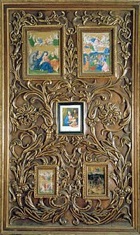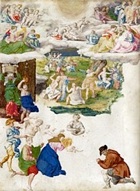

Cesare Franchi, who was probably born in Perugia, seems to have been called il Pollino because of his poor eyesight. This might well explain the fact that he specialised in miniatures. His early biographers maintain that he worked for important clients in Rome, but all of his known works are in Perugia. He could be the “maestro Cesare miniatore” who was paid by the Commune in 1583 to decorate a copy of the city statutes.
An appeal made in ca. 1600 to Cardinal Cinzio Passeri Aldobrandini in his capacity as Prefect of the Tribunal of Justice in the Vatican failed to secure the lifting of a death sentence on Cesare Franchi for a murder that he had committed in Perugia during carnival. He was therefore executed.
Perugia
Miniatures (ca. 1600)

-
✴the Holy Family with angels;
-
✴the Madonna and Child in glory with saints;
-
✴the Holy Family;
-
✴the Assumption of the Virgin; and
-
✴the Martyrdom of St Stephen.
They are now in the Galleria Nazionale.
Mystic Marriage of St Catherine (ca. 1600)
This miniature, which is attributed to Cesare Franchi, was in the Convento di Sant’ Agostino. [Is it still there?]
Miniatures (ca. 1600)

-
✴the Coronation of the Virgin; and
-
✴the Adoration of the Shepherds.
The latter (illustrated here) is unfinished, presumably because it was in progress at the time of Franchi’s arrest.
Read more:
F. Mancini, “Miniatura a Perugia tra Cinquecento e Seicento”, (1987) Perugia pp 36-42
Return to Art in: Perugia

